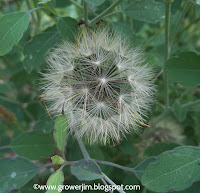Aechmea fendleri is a spring-blooming bromeliad with a vivid red and blue inflorescence. Blue tubular flowers open only briefly from each bud, but pollinated blooms develop into colorful fruits that hang on through most of the summer.
The plant grows to be over 2 feet high and wide with fairly stiff leaves. The inflorescence is held well above the foliage and is quite striking, even from a distance.
Mine get nearly full sun so the foliage has a yellowish cast. Plants in more shade would have darker green leaves. The leaf margins are lined with small spines, typical of many Aechmea species.
Winter temperatures in the mid 20s F are tolerated, but some leaf damage occurs if frost settles directly on the plant.
Thursday, May 31, 2012
Thursday, May 24, 2012
Quilquina (Porophyllum ruderale ssp. ruderale)
Quilquina (Porophyllum ruderale ssp. ruderale) is a culinary herb with a flavor that is often compared to Cilantro, but it is distinctly different. It is used with salads, sandwiches, tacos, salsas, ceviche, soups, meats and cheeses. When used in cooked foods, you should add this herb at the very end so that the flavor isn't lost.
It is native to Central and South America, but is widely grown throughout Mexico and the Caribbean. Every region seems to have its own name for this plant, and the many common names include summer cilantro, yerba porosa, anamu (meaning a strongly scented herb), chucha, guacamaya, namu, papalo, quilquina, rudade gallina, venadillo, yerba de cabra (goat plant), and yerba del venado (cattle plant).
This subspecies has elongated blue-green leaves about 1 1/2 inches in length.
This species is a summer annual for full sun. When planted in the ground, it is fast-growing and can quickly reach 4 feet or more with a naturally-rounded growth habit. The foliage color makes an attractive addition to the herb garden. They flower profusely, but the blooms are not showy, consisting of an elongated bud with a bristly-looking top.
Pollinated flowers produce puffy seed heads that are dispersed by the wind.
They will readily reseed themselves, so once you get them started you'll likely find seedlings coming up where you least expect. I pull the seedlings and use them in the kitchen.
Summer is the best time to grow this herb. During shorter days, the plant puts all its energy into flower and seed production, but the long days of summer produce plenty of leafy foliage for culinary use. Plants are fairly hardy and survive temperatures at least as low as 30° F without damage.
Quilquina is an herb that is best used fresh. I harvest it by clipping about 4 inches off the tips, including any young flower buds. They keep for at least a week when kept moist and refrigerated in a closed container.
Read about the closely-related subspecies, P. ruderale ssp. macrocephalum or Papalo.
Click here to buy seeds of Quilquina (Porophyllum ruderale ssp. ruderale)!
It is native to Central and South America, but is widely grown throughout Mexico and the Caribbean. Every region seems to have its own name for this plant, and the many common names include summer cilantro, yerba porosa, anamu (meaning a strongly scented herb), chucha, guacamaya, namu, papalo, quilquina, rudade gallina, venadillo, yerba de cabra (goat plant), and yerba del venado (cattle plant).
This subspecies has elongated blue-green leaves about 1 1/2 inches in length.
This species is a summer annual for full sun. When planted in the ground, it is fast-growing and can quickly reach 4 feet or more with a naturally-rounded growth habit. The foliage color makes an attractive addition to the herb garden. They flower profusely, but the blooms are not showy, consisting of an elongated bud with a bristly-looking top.
Pollinated flowers produce puffy seed heads that are dispersed by the wind.
They will readily reseed themselves, so once you get them started you'll likely find seedlings coming up where you least expect. I pull the seedlings and use them in the kitchen.
Summer is the best time to grow this herb. During shorter days, the plant puts all its energy into flower and seed production, but the long days of summer produce plenty of leafy foliage for culinary use. Plants are fairly hardy and survive temperatures at least as low as 30° F without damage.
Quilquina is an herb that is best used fresh. I harvest it by clipping about 4 inches off the tips, including any young flower buds. They keep for at least a week when kept moist and refrigerated in a closed container.
Read about the closely-related subspecies, P. ruderale ssp. macrocephalum or Papalo.
Click here to buy seeds of Quilquina (Porophyllum ruderale ssp. ruderale)!
Subscribe to:
Posts (Atom)







